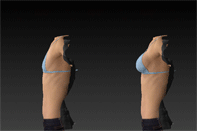One of the biggest concerns we get when it comes to breast related plastic surgery clients is scarring. Many patients are concerned that the scars related to procedures like breast augmentation and breast lifts are going to be highly noticeable and unsightly.
This is a valid concern considering it is a surgical procedure that requires incisions to be made in the skin, so unfortunately scarring is a part of that process. That being said though, there are things that the surgeon can do to help minimize scarring and there are things you can do, post-op, to help reduce the visible scars.
How a Skilled Surgeon Helps to Reduce Scars
If you’re considering a breast lift or breast augmentation, one of the most important things you can do is to trust your doctor. Finding a reputable doctor that is active in the plastic surgery community, understands what they are doing, has good reviews and referrals, is always the first place to start.
A good surgeon will listen to, and understand, your needs when it comes to minimal scarring, and will explain exactly how they go about ensuring that the scars are as invisible as they can be after healing.
In most cases, the doctor will place the incisions in areas that are normally concealed by clothing and bathing suits so that you won’t have to worry about an unsightly scar while at the beach. By placing the scars around the areola or in the creases of the breast, your surgeon will be able to hide the incisions in areas that 99% of people will never see.
Avoiding Sunlight and Using Creams
In regard to post-op care to help minimize the scars, or the color of the scars, there are a number of things you can do.
While it shouldn’t be too hard to do after your surgical procedure, we always must tell patients to remain out of the sun to avoid causing your scars to become darker. If you can’t avoid being in the sun, or just love the sun in general, be sure to put on a high SPF sunscreen to help protect your scars from the UV rays.
There are also creams available to help lighten up scars and reduce their appearance but making sure you keep your healing incision clean and properly cared for is another great way to help minimize scarring.
Using anti-bacterial cream and cleaning the incision on a regular basis will help keep any foreign germs out of the area and will allow for better healing. The smoother the healing process, the less likely for scarring complications.
Once the healing process has finished, you can use things like softening creams or silicone treatments, which both help to keep the scarring area hydrated and flexible. This will help the scar tissue appear more normal, as scar tissue itself is relatively hard compared to normal skin.
Will The Scar Ever Go Away?
Unfortunately, that scar tissue is there to stay, but over time they will be less and less noticeable. If you’re really uncomfortable with the way the incisions have healed, there are medical options to available to help reduce the look of the scars.
Laser treatments and scar revision procedures are designed to help the scar tissue blend in with the skin around it, making it less visible. It won’t completely erase the scar, but it can help to make it less noticeable to the naked eye.
Scarring is a natural part of the human body and when an incision is made in the skin there’s no getting around it. Thankfully Dr. Adams is an extremely skilled surgeon, with years of experience, that can help minimize your scarring after breast augmentation surgery.
If you’re looking for more information about scarring or want to setup a consultation to talk to Dr. Adams about breast augmentation or a breast lift, please contact Dr. William Adams Plastic Surgery in Dallas, TX today!















